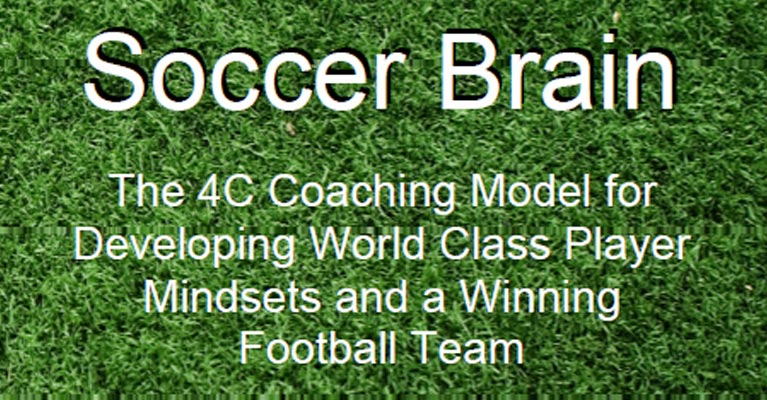Come and join the JAMBAM club. It’s a club that will help your players compete with confidence, deal with distraction and perform under pressure. It’s central message is scientifically underpinned. It’s simple to understand and easy to execute. And it can work players at all ages. Sounds too good to be true? Read on…
To start explaining JAMBAM I’m going to quote from my global bestselling book Soccer Brain:
BAM Your State
It’s frustrating isn’t it? One match your players compete in the challenge state – but the next match can be one long exercise in threat state play.
Football will always be played with fluctuation. That is the way humans work, that is the way the nervous system is designed. But the gap between best and worst performances can be lessened. It is possible to help your player immerse themselves in the challenge state and stay there more often. It is possible to have them on their toes, moving, running, making tackles and being active when it would be so easy for them to fall into the threat state.
I’d like to start your challenge state journey by giving you a simple technique to help them manage their mindset as they play. I call it ‘BAM your State’. In fact I’m regularly on the phone advising my clients to get BAMMING. I want them BAMMING from the moment they grace the pitch. I want them BAMMING in the warm up, throughout the first half and into the second half. To BAM is simple – it stands for:
Body
Action
Move
I like my players to keep their body language positive at all times. I like them to constantly look for an action to execute. And I like them to keep on the move as much as possible.
Picture that now – your players maintaining incredible body language as they compete. Their eyes are scanning the pitch and their thoughts are focused on the next action, the next play. To add to this they are on their toes – alert, alive and ready. They are always looking to move and always ready to move.
Does this picture paint the challenge or the threat state to you? How can you help your players do this more often on the pitch? Is it an instruction to give them? Should that be done in training, in the match warm up, or at some point during the game?
How you deliver this is up to you. You may insist on BAM during training. It may be a player must-do in the match script. There are many ways to introduce this concept to your team to develop your culture of commitment. I think you should – there is compelling scientific evidence that underpins the BAM process.
JAMBAM
So the above is a taken from Soccer Brain. You’ll have to purchase the book to find out more about the Challenge and Threat State as well as more about the science underpinning BAM (from Harvard University no less).
And to help all coaches I’m now establishing the JAMBAM club. What does JAM stand for? Simple- it is an acronym for Just A Minute.
You see I want as many coaches as possible to use BAM in their training sessions and on matchday. I want them to teach players to BAM for ‘Just A Minute’ at crucial parts of the game – it might be during the warm up, it might be in the first minute. It might be after they’ve made a mistake or gone a goal down.
BAM is a one stop fix for many of the mental challenges that footballers (and other sports competitors) face. BAM for JAM helps the body release the right performance chemicals that helps them feel great, play with confidence and focus their mind (testosterone, dopamine and adrenaline if you’re interested).
In the coming weeks I’ll be asking coaches for pictures and clips of their team doing the JAMBAM. I’m genuinely creating a JAMBAM club because I’m passionate that coaches and players have REALLY simple ideas related to the complex world of sport psychology.
Please spread the word. Please send in your clips and pics. Please get involved. Let’s make football psychology and sport psychology really simple…let’s bring it alive…let’s make it possible…let’s make it achievable.
Here is some more details taken from Soccer Brain:
The Soccer Body
“Nothing and no-one takes you away from your challenge state but if it does I want to see BAM. I want to see incredible body language. I want to see you ready for action. I want to see you on your toes and moving.
It is your body that will keep you focused and confident and attuned to the right intensity levels. It is your body that must lead. It is your body that slows to relax and it is your body that accelerates to work harder.”
The 21st century coach drives her players’ body language. She keeps them upbeat and sharp and ready and alert and alive. She keeps them BAM no matter what.
You make a mistake…BAM
You go a goal down…BAM
You go a goal up…BAM
You play against a gigantic centre back…BAM
You give the ball away…BAM
You play the league leaders…BAM
On your watch, nothing and no-one takes your players away from the challenge state. They stay in that state by keeping incredible body language. They stay BAM. If they do veer into the threat state they shift their body language. They get back to BAM.
This is such a simple concept to relate to your players (and I suggest you do!). But it’s not always easy for them to execute. If your team goes a goal behind, many of your players will drop their heads. BAM becomes the last thing to focus on. You have to make it their first thought. If a player makes a couple of mistakes in training her thoughts dwell on the past and her body slumps. She slows up. She becomes all consumed by the mistakes. It’s tough for her to get her mind back on the game. It’s difficult for her to get back into the present. For her to think about body language or BAM in this moment is enormously challenging. This is where your coaching comes in. Specifically, your communication with her. This is when you can offer practical support. She’s not weak or incapable of being tough, she just needs some guidance. She doesn’t need to be shouted at – she’s doing that herself. She needs a practical idea to help her get her mind and her game back in gear.
“Keep that body up. Keep moving, keep working, and stay alert. Stay up, stay up. Let your body drive how you feel.”
Help her shift away from the negative back into the challenge. That is your job, and that is the influence you need. That is coaching.




